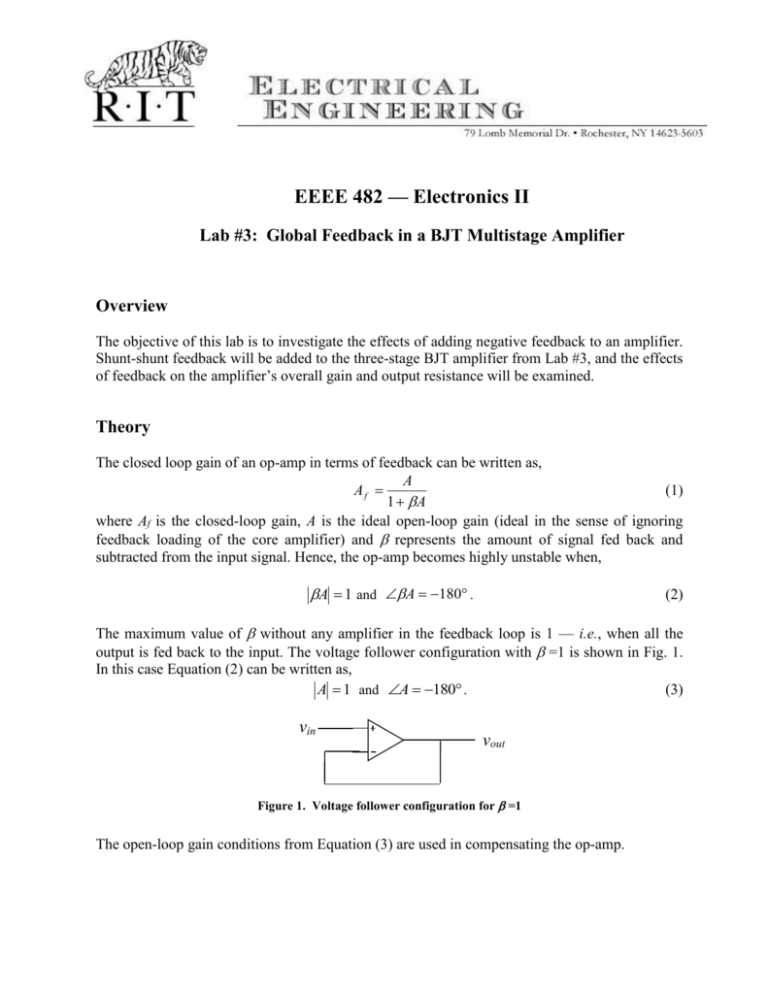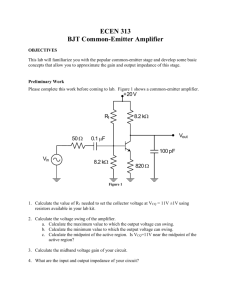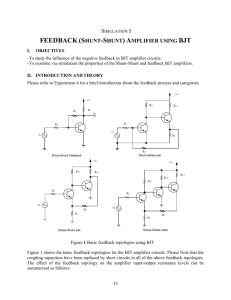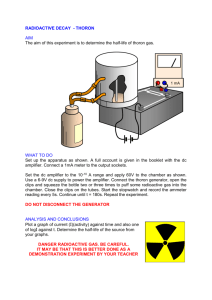EEEE 482 Lab3_Rev2015_1 - People
advertisement

EEEE 482 — Electronics II Lab #3: Global Feedback in a BJT Multistage Amplifier Overview The objective of this lab is to investigate the effects of adding negative feedback to an amplifier. Shunt-shunt feedback will be added to the three-stage BJT amplifier from Lab #3, and the effects of feedback on the amplifier’s overall gain and output resistance will be examined. Theory The closed loop gain of an op-amp in terms of feedback can be written as, A (1) Af 1 A where Af is the closed-loop gain, A is the ideal open-loop gain (ideal in the sense of ignoring feedback loading of the core amplifier) and represents the amount of signal fed back and subtracted from the input signal. Hence, the op-amp becomes highly unstable when, A 1 and A 180 . (2) The maximum value of without any amplifier in the feedback loop is 1 — i.e., when all the output is fed back to the input. The voltage follower configuration with =1 is shown in Fig. 1. In this case Equation (2) can be written as, (3) A 1 and A 180 . vin vout Figure 1. Voltage follower configuration for =1 The open-loop gain conditions from Equation (3) are used in compensating the op-amp. The three-stage amplifier that was designed, built, and tested in Lab #3 is shown in Figure 2. The amplifier had an unloaded (RL ) target voltage gain of 800 V/V. In testing, the voltage gain was determined both for the unloaded condition as well as for RL = 1 k. Although the presence of a finite load lowers the gain of the third (class AB) stage, the overall gain of the amplifier increased due to the more effective loading of the common-emitter middle stage. VCC = +12 V 10 F RC1 RC2 RE1 Q3 Q2N3906 10 k 10 F Q1 100 vid RE2 ii Q2 100 ~ Q4 Q2N3904 Q2N3904 Q6 100 Rout vo 6 mA Q2N3906 Q5 100 RL Q7 Q2N3906 RC3 –VEE = –12 V Figure 2. Multistage Amplifier The overall gain of the three-stage amplifier will be referred to as the “open-loop” gain A in the context of feedback analysis. In the presence of ideal feedback, the closed-loop gain Af would be calculated using A in Equation (1). In addition to the original three-stage amplifier circuit shown in Figure 2, the output resistance Rout of the overall amplifier is indicated. Inasmuch as the class AB output stage is fundamentally a pair of emitter-followers, the output resistance of the overall amplifier is dominated by the inherently-low output resistance of the output stage. Note that Rout is defined, as always, as being exclusive of the load RL. Electronics II – EEEE 482 — Lab #3: Global Feedback in a BJT Multistage Amp — Rev 2015_1 Page 2 of 6 Rochester Institute of Technology Dr. Lynn Fuller, et.al. Figure 3 shows a modification to the three-stage amplifier of Figure 2. In Figure 3, a feedback network comprised of resistor RF has been added so as to incorporate shunt-shunt negative feedback. The effect of shunt-shunt feedback is to stabilize the transimpedance (transresistance) of the overall amplifier — i.e., the transfer function vo/ii — where the input current ii is shown in Figure 3. VCC = +12 V 10 F RC1 RC2 RE1 Q3 Q2N3906 10 k 10 F Q1 100 vid RE2 ii Q2 100 ~ Q4 Q2N3904 Q2N3904 Q6 100 Rout vo RF RL No connection here Q2N3906 Q5 6 mA Q2N3906 100 Q7 RC3 –VEE = –12 V Figure 3. Multistage Amplifier with Shunt-Shunt Feedback The effect of the feedback loading on the core three-stage amplifier is to modify the open-loop gain from its ideal value to a modified value A. The modified open-loop gain is then used in Equation (1) to obtain the closed-loop gain: A Af . (4) 1 A Electronics II – EEEE 482 — Lab #3: Global Feedback in a BJT Multistage Amp — Rev 2015_1 Page 3 of 6 Rochester Institute of Technology Dr. Lynn Fuller, et.al. Additionally, the effect of shunt feedback at the output is to lower the output resistance by the “amount of feedback”: Ro Rof (5) 1 A where Ro is the open-loop output resistance of the modified amplifier, including (in parallel) the original output resistance of the three-stage amplifier, the feedback loading due to RF, and — temporarily — the load resistance RL. In the case of shunt feedback at the output, the calculated quantity Rof is not the true output resistance Rout of the feedback amplifier, but is closely related to it: (6) Rof Rout RL . The parallel combination can be undone to obtain the actual output resistance Rout . Electronics II – EEEE 482 — Lab #3: Global Feedback in a BJT Multistage Amp — Rev 2015_1 Page 4 of 6 Rochester Institute of Technology Dr. Lynn Fuller, et.al. Pre-Lab 1) Analyze the original three-stage amplifier as designed in Lab #3 (as shown in Figure 2) to calculate its output resistance Rout. The output transistors Q6 and Q7 should both be assumed to be on and, therefore, operating in parallel for purposes of finding Rout. (The justification for this is that the DC output operating point was designed to be close to 0 V, and both transistors are biased so as to be on the edge of turning on.) 2) Calculate the transimpedance “gain” A = vo/ii of the three-stage amplifier in Figure 2. This can most easily be done by converting the already-known voltage gain (effectively, do several source transformations of the vsig–10 k–100 voltage source divider to determine the ratio of vsig to small-signal current ii flowing into Q1). 3) Design the feedback amplifier of Figure 3 (i.e., choose RF) to obtain an approximate closed-loop gain Af of –27 k. Keep in mind the fact that the resistor value used must be a standard 10% tolerance value. 4) Do standard feedback analysis on the three-stage feedback amplifier of Figure 3 with RL removed (i.e., with RL ) to calculate three quantities: the modified open-loop gain A (in k or M), the closed-loop gain Af (in k), and the output resistance of the feedback amplifier Rout. 5) Simulate the feedback amplifier (with RL removed) and obtain simulation values for the modified open-loop gain A, the closed-loop gain Af, and the output resistance of the feedback amplifier Rout. (To find the output resistance through simulation, kill vsig then apply a small-amplitude test source with 10 kHz frequency to the output node. The ratio of the test-source amplitude to the small-signal current delivered by it is the small-signal resistance at that node.) 6) Use simulation to determine the output resistance of the amplifier with no feedback. Determine the small signal output voltage with no load and with 100 ohms load. Using the results calculate the value for output resistance. 7) Use simulation to determine the output resistance of the amplifier with feedback. Determine the small signal output voltage with no load and with 100 ohms load. Using the results calculate the value for output resistance. Electronics II – EEEE 482 — Lab #3: Global Feedback in a BJT Multistage Amp — Rev 2015_1 Page 5 of 6 Rochester Institute of Technology Dr. Lynn Fuller, et.al. Lab Exercise Modify the three-stage amplifier circuit built in Lab #3 to include the shunt-shunt feedback (RF) as designed in your Pre-Lab preparation. Remove the 1 k load (RL) if your last measurements in Lab #3 included it. Make the following measurements: 1) Closed-loop gain, Af = vo/ii of the feedback amplifier of Figure 3. Note again that the “gain” of the feedback amplifier is a trans-resistance (units of ohms). This is done by measuring the voltage gain with feedback vo/vsig then multiplying by the Thevenin resistance of the source. (Rth is as found in the pre lab using source transformations). 2) Output resistance Rout of the original amplifier of Figure 2. 3) Output resistance Rout of the feedback amplifier of Figure 3. Lab #4 Tech Memo Guidelines 1) Design of feedback (a) Show calculations of the output resistance Rout and transimpedance “gain” A = vo/ii (in k or M) of the original three-stage amplifier (Figure 2). (b) Show design calculations for RF in the feedback amplifier of Figure 3. (c) Show calculations of the modified open-loop gain A (in k or M), the closed-loop gain Af (in k), and the output resistance of the feedback amplifier Rout. 2) Comparison of measurements to design and simulation (a) Compare the three closed-loop gain values Af obtained in your design calculations, your simulations, and your measurements, and discuss any differences. (b) Compare the output resistance values Rout for the feedback amplifier of Figure 3 obtained in your design calculations, your simulations, and your measurements, and discuss any differences. (c) Compare the output resistance value Rout measured for the original amplifier (Figure 2) to that measured for the feedback amplifier (Figure 3). Electronics II – EEEE 482 — Lab #3: Global Feedback in a BJT Multistage Amp — Rev 2015_1 Page 6 of 6 Rochester Institute of Technology Dr. Lynn Fuller, et.al.









